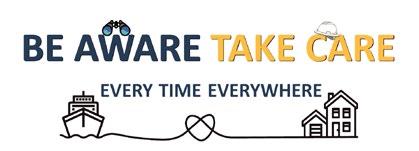

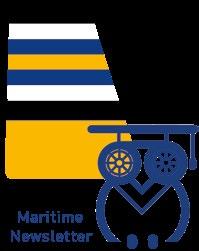
To reach our Seafarers ISSUE 87 MARCH 2024 Company News 2 EU ETS – Emissions Trading System 7 Mitigating the risk of collision with fishing boats in Chinese Waters 10 A day in the life of a Crewing Assistant 12 Voices from the Fleet 13 Safety First 14 IN THIS ISSUE Mental Well-Being 16 Introducing our Shore Staff 18 Moving Forward, Looking Back 20 Pioneers of the Waves 22 Survival at Sea 24
One topic that surfaces in several articles in this issue is embracing diversity. In order to embrace diversity, it is first necessary to remove the barriers of bias and prejudice that are founded on a negative view of those whose appearance, views, values, beliefs and perspectives do not tie in with our own. This can prove difficult, especially when people refuse to acknowledge that anything but their own world view has any merit. However, it is not an impossible task as appreciation and respect can be cultivated through the development of an open mind.
Another stumbling block appears when individuals or cliques actively despise others for being different. Unfortunately, this mindset can occasionally prevail among those in higher positions. When it does, it often leads to people using their hierarchical status to harass, belittle or simply look down on subordinates (as brilliantly illustrated in the video shown in recent Company Forums). The only effective way of preventing this despicable trait is to adopt a zero tolerance approach to such behaviour.
As indicated in the Safety First and Mental Well-Being sections, whose contributors actively practise what they preach in other articles, appreciation and respect are the cornerstones of embracing diversity, and instances of these can be found throughout this issue. In the piece on our Canteen Staff, for example, their culinary skills are openly applauded. In this instance, it appears that a leaf has been taken out of our Seafarers’ book as you rightly sing the praises of your Galley Crew when they create delicious dishes. What is more, this article highlights the need to express appreciation, and not merely think that it is deserved. A further display of appreciation appears in the Voices from the Fleet section, in which it is revealed that 2nd Engineer, Denys Isaiev, donated his lucky coin to two of his colleagues in the galley! Yet another potential obstacle to embracing diversity is considering others whose work is regarded as less important to be inferior. This point of view is often based on an inflated perspective of self-importance or stereotyping. The best way to eliminate
this mindset is to learn about the duties and responsibilities of colleagues. An opportunity to do this can be found in the Crew Department article on Crewing Assistants. This piece sheds light on their challenges and capabilities, which firmly dispel the idea of an assistant being someone who possesses few highly appreciated skills. Likewise, in the new section called Introducing our Shore Staff, the focus is on the Accounts Department. This piece shows just how divers the members of this department are and how they do not remotely conform to any stereotype of a person working in accountancy.
Elsewhere, there are definite notes of optimism. Natassa Sakellariou introduces the EU ETS – Emissions Trading System in the Technical section, while Capt. Delson Roche successfully navigates the potentially stormy seas of collisions with fishing boats in Chinese Waters. In Moving Forward, Looking Back, the trend continues in Vaia Kyrodimou’s interview with Fivos Christopoulos, which elicits an optimistic attitude towards the Company’s future from the interviewee.
There is a distinct air of positivity in this issue, so I would like to thank all the contributors for their submissions that have highlighted the need to see the glass as being half full. To my mind, this is of the utmost importance. After all, isn’t life about maintaining positivity in the face of social, psychological, economic and environmental challenges so that a favourable outcome can be achieved? You will find other examples of appreciation and respect in articles that have not been mentioned in this editorial. See if you can find them.
I sincerely hope you enjoy this issue of Wavelength. If you have any comments, suggestions or questions regarding the content, please do not hesitate to contact me at contact@wavelength.gr.
Best
wishes, Nick Seaman
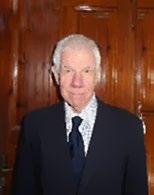
Pitta Cake Cutting
Following the tradition of cutting the pitta, a gathering took place at Head Office for all our colleagues on February 20th. There were five lucky coins in the pitta and the search for them is always filled with anticipation, resulting in joy for those whose pieces contain a coin. This year’s winners were Eleni Mathioudaki (Crewing Assistant), Tina Korosi (KPI Controller), who was successful for the second year in a row, Mando Rodopoulou (Freight Collection Officer), Oleksandr Soshyn (SBTRN Officer) and Vasilis Moulos (Superintendent Engineer).

instructions and procedures issued by the owners, managers, flag etc. The articles presented and the views
reflect those of the publishers. Editor: Nicholas Seaman • Email: contact@wavelength.gr •
Disclaimer: The contents provided herewith are for general information purposes only and are not intended to replace
otherwise contradict the detailed
in
necessarily
Design-Production: www.remdesign.gr
or
expressed
the bulletin do not
Dear seafarers, Editorial
. Company News Enjoying the pitta and social interaction at the event 2 Issue 87-March 2024
Along with the pitta cutting, the winners of our Padel tournament, namely Elli Moretti (DPA/SQE Manager), Nikos Stavrakis (Tanker Chartering Manager), Evaggelos Kollintzas (Dry Chartering Manager), Mina Kotsaki (Forwarding Officer), Margarita Tsaousi
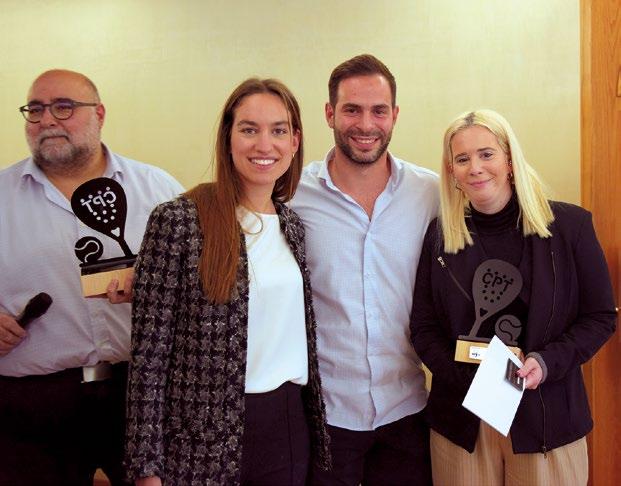
Our Canteen
In the bustling kitchen of our esteemed shipping Company's canteen, our dedicated team of cooks transforms the daily bounty of fresh, high-quality ingredients into culinary delights that satisfy different tastes. The team of Irini, Marina and Vicky, our chefs, craft a diverse menu that caters to the tastes and preferences of our colleagues.
Irini Chalidi started with us back in 1997 as an assistant and later on became the Chief Cook, always ensuring that the food is prepared and served on time, making her colleagues happy.
Marina Antoniadou, joined the team later on, in 2004, when she formed with Irini an inseparable duo. Her desserts, always prepared in the healthiest manner, offer a different, creative note on which to end the meal.
The latest addition, our junior, Vicky Vaporaki, has been with us for a year now and has brought with her fresh ideas for the menu, making it even more delightful.
You will see them arriving earlier than the office staff to bake bread and prepare each day’s nutrient rich meals. When you

(Chartering Broker) and Lefteris Alefragkis (Senior MGA Controller) received their prizes.
Thanks are due to Jenny Karakoulouxi for recording the event with such great pictures.

meet them, they will greet you with a broad smile and you will feel their heartfelt care instantly. When you enter the canteen, you are greeted by the smell of a home-cooked meal. Homemade meals are profoundly important in fostering health, well-being and a sense of connection. They embody love and care, keeping our energy levels high, promoting overall mental health and optimal productivity in our daily endeavours.
Cooking for a large number of people is a pretty demanding task. Still, our ladies in the restaurant have coped with all challenges and cater for our needs with love and care. We could not be more thankful.
 Eleni Prokopiou with padel runners-up Evaggelos Kollintzas and Mina Kotsaki and our fastidious MC Anthony Lambros taking a short, wellearned breather
Eleni Mathioudaki and Mando Rodopoulou displaying their lucky coins
Tucking into a mouthwatering dish
Eleni Prokopiou with padel runners-up Evaggelos Kollintzas and Mina Kotsaki and our fastidious MC Anthony Lambros taking a short, wellearned breather
Eleni Mathioudaki and Mando Rodopoulou displaying their lucky coins
Tucking into a mouthwatering dish
3
Our cooks conjuring up culinary delights in the kitchen
The Padel Tournament
The Centrofin Padel Tournament (CPT) took place between September and December 2023. Participation was impressive with 24 mixed double teams taking part. The teams were divided into four groups of six. Each team represented a ship from the fleet. The 24 teams were formed after a draw and they all played against each other within their group. The first two teams from each group qualified for the quarter finals. Those eight teams that qualified from the group stage were Casta Diva, Apageon, Guardian and Venture from the dry fleet together with Sereno, Apanemo, Semeru and Pserimos from the tanker fleet.
The four quarter finals were extremely competitive matches with Guardian and Casta Diva from the dry fleet together with Semeru and Sereno from the tanker fleet progressing to the semi-finals. After two very close matches the two teams that reached the final were Guardian and Sereno. The final was a very competitive and tight match that went to a decisive third set with Guardian taking first place. In the post-match ‘analysis’, it emerged that victory had been achieved by identifying a weakness (Elli’s unforced errors due to nerves) and finding a solution, a course of cooperative action the importance of which extends far beyond the padel court.
So, the final rankings of the CPT were 1.Guardian (represented by Elli Moretti & Nikos Stavrakis) 2.Sereno (represented by Evaggelos Kollintzas & Mina Kotsaki) 3.Semeru (represented by Lefteris Alefragis & Margarita Tsaousi) 4.Casta Diva (represented by Katerina Diamandopoulou & Konstantinos Leonis).
Overall, the purpose of the tournament was to get together, become familiar with a new sport and last but not least have lot of fun. All of the above goals were achieved and we are now looking forward to the second CPT as the standard is higher because all the teams showed great improvement. Congratulations to all the participants who are sure to keep training harder to increase their chances of winning the next tournament.
Centrofin Basketball Team
This is the first season our Company has participated in the Shipping Basketball League of the Greek Commercial League. The Commercial League was established in 2006. It is a sports union for employees of companies and organizations whose aim is to promote a healthier lifestyle, sports activities and team spirit among the staff of every company.
The participation and support from our colleagues and management was beyond expectation. The team consists of 24 players, both men and women; some of them have played in the past while others just love the sport. As it is our Company’s first participation, we were enlisted in Shipping League C, which comprises 9 shipping companies. Another 18 shipping companies in total play in Shipping Leagues A and B. During the regular season, 16 games have to be played by each team, with the first 4 teams competing in the playoffs in May. During April, the basketball cup is contested by all 27 of the Shipping League’s companies. After a draw has been made, the competition will take on a knock-out format.
Our team is currently 1st in Shipping League C and is the favourite to take the 2023-2024 title as our players’ skillset and team work is incomparable in this tier. Let’s enjoy the rest of the season and achieve our goal!
Finally ,the tournament was not without interest to our Seafarers: the winning team (Guardian) belonged to the Kamsarmax & Ultramax group and provided our Seafarers sailing on ships of this type with free internet cards as a prize.
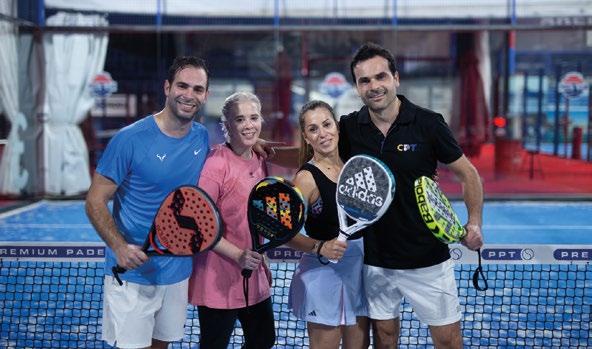

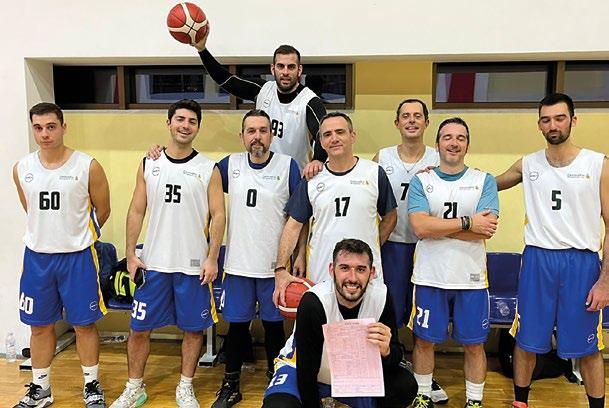 Our basketball team
The finalists after their epic battle
The action on court provoked a range of reactions
Our basketball team
The finalists after their epic battle
The action on court provoked a range of reactions
4 Issue 87-March 2024
Yannis Xintarakos, George Stavrakis, Marios Strongyloudis, Yiannis Vakkas, Grigoris Kamaras, Christos Kartsonas, Yiannis Procopiou, Michalis Maritsas and Thanasis Alexandropoulos.
Onboard Promotions
In the previous quarter, there were thirty nine promotions. That was an impressive number, but in the fourth quarter it was surpassed, with a total of forty one of our Seafarers receiving a promotion. This is truly a reflection of the hard work and effort being put in by the Company’s seafaring community, which is fully deserving of a special mention. This list of those ratings and officers who were promoted along with their vessels and promotion details in chronological/alphabetical order appears in the table below.
Each and every one of our Seafarers on the list is to be warmly congratulated. All of you have performed admirably and have proved you are capable of taking on greater responsibility, especially the newly promoted Chief Engineer, Samuel Artuz, and Master, Mohit Jain.
As aptly put by a contributor to Wavelength 85 aboard MV Irina, you all have “indispensable skills” and continuously demonstrate your dedication and loyalty, which are undoubtedly highly valued attributes. Last, but not least, let it be known that your work is always greatly appreciated and recognised as being something extraordinary.

Date of Promotion Name Vessel Promotion Details 01.10.23 INOC Hetlir AMALIA M. WPR to ASE 09.10.23 QUIROZ Benjamin Jr. SMYRNA E/Tr. to WPR 11.10.23 CAMACHO Jay Von APAGEON OS to ASD 11.10.23 MONTE Kevin APAGEON D/Tr. to OS 12.10.23 MANGAOANG John Paolo NILOS D/Tr. to OS 12.10.23 ODCHIGUE Aezar John NILOS ASD to BSN 14.10.23 VILLANUEVA Christian IRINA WPR to ASE 16.10.23 MATES Michael John POPI P. E/Tr. to WPR 16.10.23 RAYA Elmer NAMRATA E/Tr. to WPR 17.10.23 ANTE Benedict RUBY 3/M to 2/M 18.10.23 LIMON Ronnel CORAL ISLAND OS to ASD 18.10.23 LORICA John Paul CE-BERMUDA WPR to ASE 20.10.23 GUNTU Ramaraju CE-BERMUDA 4/E to 3/E 21.10.23 ALINSASAGUIN Michael APAGEON ASD to BSN 21.10.23 DORIA Nestor Jr. ALLIANCE MMN to STWRD 22.10.23 MISHRA Abhishek AGIOS NIKOLAOS 3/M to 2/M 01.11.23 LORBES Mark Lee LENI P. 4/E to 3/E 06.11.23 BACHO Judiel AMALIA M. WPR to ASE 06.11.23 VINLUAN Marrion AMALIA M. OS to ASD 07.11.23 MORALES Jason DINO D/Tr. to OS 07.11.23 NIEDO Ariel ANDONIS MMN to OS Date of Promotion Name Vessel Promotion Details 07.11.23 REDITO Gian Carl POPI P. D/Tr. to OS 09.11.23 ARTUZ Samuel IRINA 2/E to C/E 10.11.23 ENRIQUEZ Mark Lorence LENI P. OS to ASD 20.11.23 VILLARUZ Ryan VENTURE 3/M to 2/M 21.11.23 COMPETENTE Norman Buddy CAPTAIN A. STELLATOS WPR to ASE 21.11.23 DIZON Earl Jan CAPTAIN A. STELLATOS C/Tr. to A/C 24.11.23 SINGALIVO Ralph Joenes CORAL ISLAND OS to ASD 25.11.23 TABON Paquito Jr. DANAE WPR to FTR 01.12.23 KOSHELAP Denys DINO 3/E to 2/E 01.12.23 KURTIEV Dmytro DINO APR/ELEC to ETO 04.12.23 BEBILLO Vergil James ANDONIS OS to ASD 04.12.23 CERILLO Joewel Jr. CASTA DIVA MMN to STWRD 04.12.23 JAIN Mohit SEMERU C/O to MSTR 06.12.23 DEUDA Eugenio CE-HAMILTON ASD to BSN 07.12.23 BALDONA Jose Jerry Jr. RUBY ASD to BSN 07.12.23 FABELCON Lawrence Clyde RUBY OS to ASD 09.12.23 SITONES Stephen PHILIPPOS A. OS to AB 11.12.23 CABARRUBIAS Jumar CE-BERMUDA D/Tr. to OS 19.12.23 MILANO Romel SEMERU OS to ASD 20.12.23 FLORES Belly Joe RUBY OS to ASD
5
Officers’ Forum India
This year started with our Officers’ Forum that took place in Goa, India on 27-28th February 2024. CENMAR India being the host, after almost five years, welcomed our Indian Seafarers for a twoday event in a different location, thus putting into practice our motto “Embracing the tides of change” and further building team spirit. This year’s event faced a lot of challenges during the organizational phase, but the lesson learned was that by being resilient at all times we have the opportunity to perform different roles and discover our qualities and abilities. It always remains satisfying to witness the participation of a large number of Seafarers; in this case, there were 53 Deck and Engine Officers.
A very touching moment in the Forum was the silence held in the memory of our Superintendent Engineer Mr. Stratos Palaiologos, who passed away last January.
Another heartfelt moment was the discussion between Ms. Elli Moretti, DPA/SQE Manager and Chief Officer Sahoo Umasankar sharing the unfortunate suicide case on board M/V Alexia some years ago. It is such moments that both heal our wounds and provide further insight into such cases so that they may be avoided in the future.
A variety of topics was included in the Forum agenda, including the latest shipping industry demands, the Company’s experiences and Case Studies as well as Soft Skills Awareness.
The Forum was followed by a dinner held on the first night, where the Officers and their families had the opportunity to discuss and enjoy the moments with the team from Head Office. The event closed with the loyalty awards to the Officers who have

been with the Company for a period of time ranging from seven to fourteen years.
The Forum, along with the videos presented, was streamed live and is available on Youtube, under Centrofin’s channel. You may find highlights from previous CENMAR events in: https://www.centrofin.gr/forum/past/ Request the password from our CENMAR team.
The “CENMAR Forum” is the inseparable link between Seafarers and the Head Office. Not only does it make our relationships stronger but it also validates our feeling that we are all part of a great family.
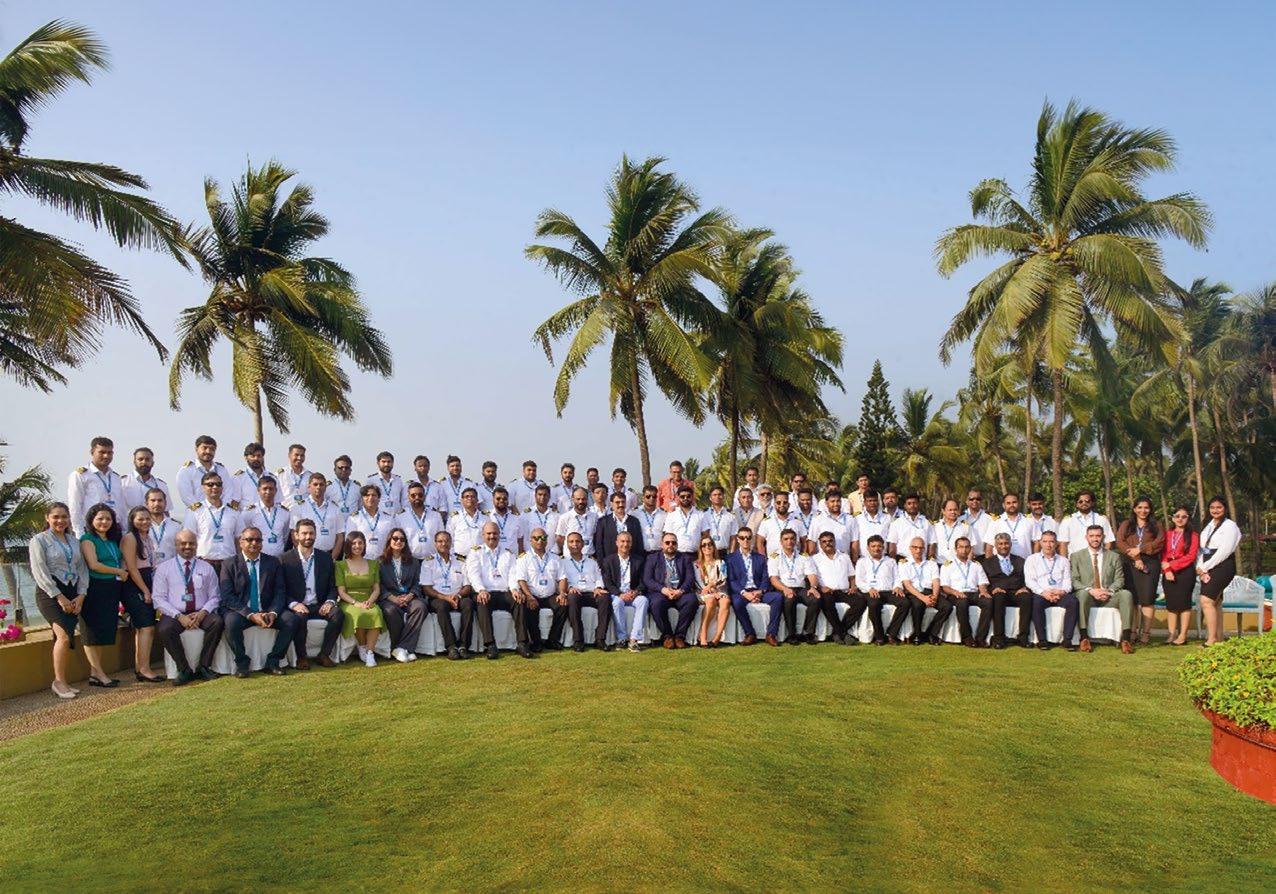
6 Issue 87-March 2024

EU ETS – Emissions Trading System
While maritime transport is one of the most energy-efficient modes of transport, it is also a large and growing source of greenhouse gas emissions. Projections show that emissions could increase by up to 130% of 2008 emissions by 2050, which would undermine the objectives of the Paris Agreement: a global framework to limit global warming to below 2°C and pursuing efforts to limit it to 1.5°C.
At the EU level, maritime transport represents 3 to 4% of the EU’s total CO2 emissions. The EU action to make sure maritime transport plays its part in achieving climate neutrality in Europe by 2050 was to include maritime emissions in the European Union Emissions Trading System (EU ETS). EU ETS is a part of a series of legislative proposals known as the “Fit for 55” package aiming to reduce its net greenhouse gas (GHG) emissions by at least 55% by 2030, compared to 1990 levels. The EU “Fit for 55” package is part of the European Green Deal which aims to reach full decarbonization by 2050.

What is EU ETS?
The EU ETS is an emissions cap-and-trade system market based measure (MBM) that aims to reduce greenhouse gas (GHG) emissions. It has two principles, setting a limit or cap on the yearly maximum amount of GHG emissions and the trading of EU emission allowances (EUAs)
EU Allowances (EUAs) are a type of carbon allowance that allows companies covered by the EU ETS to emit GHG emissions equivalent to the global warming potential of one tonne of CO2 equivalent.
A carbon dioxide equivalent is a metric measure used to compare the emissions from various greenhouse gases on the basis of their global-warming potential (GWP).
Each year, a limited number of EU Allowances (EUAs) is made available for trading in the market, and this is reduced yearly in order for the EU to meet its target of a 55% reduction in GHG emissions by 2030 relative to 1990, and net zero by 2050.
 By Natassa Sakellariou
By Natassa Sakellariou
In order to push the industry towards greener and more efficient technologies, the Union–wide allowances for each year will be reduced by a linear factor equal to 4.3% from 2024 to 2027 and 4.4% from 2028 to 2030.
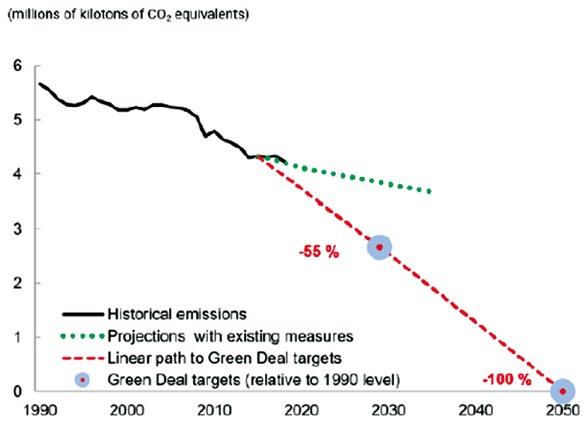
What does EU ETS mean for shipping companies?
Starting from January 2024, the EU Emissions Trading System has been extended to cover CO2 emissions from all large ships (of 5,000 Gross Tonnage and above) entering EU ports, regardless of the flag they fly.
Shipping companies will have to surrender allowances for:
- 50% of emissions from ships performing voyages departing from an EU port to a non-EU port
- 50% of emissions from ships performing voyages departing from a non-EU port to an EU port
- 100% of emissions from ships performing voyages from an EU port of call to another EU port of call
- 100% of emissions from ships at berth in an EU port
The shipping industry will have a three-year phase in period, where companies will have to surrender allowances only for part of their emissions.
The transitional period will be:
- 40% of verified emissions in 2024
- 70% of verified emissions in 2025

- 100% of verified emissions in 2026
Shipping companies covered by the EU ETS can emit tonnes of CO2 up to the amount of their allowances.
If they have insufficient allowances, they can either:
Technical
Figure 1: Fit for 55 – The EU’s plan for a green transition (European Council and the Council of the EU)
Figure 2: EU total reduction targets
7
- Acquire additional allowances
- Reduce their carbon emissions to an equivalent level of their allowances

companies to reduce emissions through measures such as operational efficiencies, investments in low-carbon technologies and adopting alternative fuels

Shipping companies that fail to surrender the equivalent amount of EUAs based on their emissions, will have to pay a penalty of 100 euro per tonne CO2e and are still liable for surrender of the required allowances. Failure to comply for two or more consecutive periods may result in the ships of the company being banned from trading in the EU.
The EU ETS would initially cover the CO2 emissions and be widened to include methane (CH4) and nitrous oxide (N2O) from 1 January 2026.
How will the revenues from EU ETS be used?
The revenues arising from EU ETS will fund investments such as:
- R&D and demonstration projects that aim to reduce GHG emissions
- Development of renewable energies and other technologies that contribute to the transition to a safe and sustainable low-carbon economy
- Environmentally safe carbon capture and storage

EU ETS Cost implications for Shipping
The cost of purchasing allowances under the EU ETS can be a significant expense for shipping companies and this is likely to have implications for pricing and other terms of contractual agreements between parties across the value chain, including charterers and cargo owners.
This will necessitate a common and trusted basis of emissions performance data for voyage verification for all parties to manage substantial tax cash flows across the value chain.
Overall, the EU ETS will have an impact on operations, costs and contractual agreements. It is designed to encourage shipping
- Measures intended to improve energy efficiency and clean technologies in the sectors covered by EU ETS Furthermore, each year until 2030 the revenue from the auction of 20 million allowances (i.e. about €1.6 billion with a price of €80 per allowance) will be included in the Innovation Fund to support investments for the decarbonization of the maritime sector and especially:
- Improvement of the energy efficiency of ships, ports and short-sea shipping
- Electrification of the maritime sector Investments in sustainable alternative fuels such as hydrogen and ammonia
- Investments in zero-emission propulsion technologies e.g. wind propulsion
- Innovations to ice class ships
Monitoring
• By 31 December 2023 or the soonest possible before 1 April 2024, shipping companies should submit to their verifier the updated Monitoring Plans (MPs) for each of their ships.
• By 1 April 2024, shipping companies shall submit to their Administering Authority the MPs that have been assessed by the verifier.
• By 6 June 2025, the responsible administering authority
 Figure 3: EU ETS based on percentage of emissions on voyages (DNV)
Figure 4: EU ETS introduction timeline (DNV)
Figure 3: EU ETS based on percentage of emissions on voyages (DNV)
Figure 4: EU ETS introduction timeline (DNV)
8 Issue 87-March 2024
shall approve the MP, based on the assessment of the verifier.
Reporting
• From 1 January 2024, shipping companies shall monitor and report emissions for cargo and passenger ships of 5000GT and above in accordance with the revised MP.
• From 31 March 2025 and each year after, companies shall, for each ship under their responsibility, submit to their administering authority, flag states concerned and the European Commission, an emissions report for the entire
monitoring period of the previous year which has been verified as satisfactory by their verifier.
• From 31 March 2025 and each year after, shipping companies shall submit to their administering authority a verified emissions report at company level (aggregated emissions data under ETS).
• By 30 September 2025, shipping companies will have to surrender sufficient EU emissions allowances (EUAs) corresponding to their verified GHG emission of the previous monitoring.


Embracing a new path of growth and success

"Investing in yourself is the best investment you will ever make. It will not only improve your life, it will improve the lives of all those around you."
Robin S. Sharma
I am 3rd Officer Melindo, Pio Jr. S., a newly hired officer from CENMAR, a manning agency from Manila. I recently boarded M/V Stefanos, a bulk carrier, my first vessel in this Company. I had already been a 2nd mate for seven months in my last company, but due to the lack of an available ship they could not rehire me on a requested date. So, I decided to make a career move for my growth and success, both for me and my family. I accepted a position one step down from my previous rank to start from scratch and to be more worthy of a forthcoming promotion. Now, I am embracing a new path for my growth of success with this Company that allows for the growth of their officers and crew with the health and safety campaigns and sharing a common vison:
"BE AWARE, TAKE CARE, EVERY TIME, EVERYWHERE"
I am not worried about my personal growth, health and safety while on board because I believe that the Company is not only looking out for its own growth but for the growth, health and safety of their officers and crew as well. If we have this kind of mindset that the Company gives us, I believe we can be more fruitful in our jobs and have the peace of mind to finish our contract and get home to our family safely.
Thank you and I am grateful to be a part of this Company.
 Voices from the Fleet (1)
Figure 5: EU ETS Directive Application (ABS)
Voices from the Fleet (1)
Figure 5: EU ETS Directive Application (ABS)
9
by 3/M Melindo Pio
Marine Operations
Mitigating the risk of collision with fishing boats in Chinese Waters
 By Captain Delson Roche
By Captain Delson Roche
Navigating the bustling waterways of China is a delicate dance. Large cargo ships and tankers, with their immense tonnage and limited manoeuvrability, can be particularly hazardous to the smaller, often less visible fishing vessels. This constant encounter presents a complex and ever-present risk of collision. Understanding the unique challenges and adhering to strict regulations are important to navigating these waters safely. This article delves into the statistics, common causes, and crucial precautions to ensure a safe and responsible passage through China's vital fishing grounds.
Discerning seafarers must navigate through the world’s largest 500,000-strong Chinese fishing fleet in Chinese Waters. This is fraught with risks, as shown by the statistics:
• Fog lurks around every corner: Up to 80 foggy days envelop vast areas, stretching for hundreds of kilometres and obscuring potential hazards.
• Collisions lurk in the dark: Two major P&I clubs alone recorded 150 collisions between 2015 and 2020, with most occurring at night or in bad weather. The night hours, between 2300 and 0400, seem to be particularly dangerous, according to China's Maritime Safety Administration (MSA).
• Human cost too high: From 2019 to 2021, these collisions between merchant and fishing vessels claimed the lives of 248 Chinese fishermen, a stark reminder of the human cost arising from such collisions.
• Lax vigilance plays a deadly role: Poor bridge watch keeping, overreliance on a single navigation aid, and poor understanding of the limitations of technology like AIS, ECDIS, RADAR, and VHF are often contributing factors.
But the danger doesn't solely stem from merchant vessels. Fishing boats themselves contribute to the risk:

• Unmanned and adrift: Some fishing vessels drift through shipping lanes with crews asleep, leaving no lookout to spot oncoming danger.
• A tangled web of vessels: The close proximity between fishing boats creates a navigational maze, further complicated by


incorrect or non-existent navigation lights and a lack of understanding of collision regulations.
• Confusing communication and last-minute manoeuvres: Miscommunications on VHF channels and sudden changes in course to protect fishing gear add to the already tense situation.
ships regular route of ships collision incident happens frequently collision incident happens often collision incident happens incidentally
Source: Circular PNI 1708 of HUATAI INSURANCE AGENCY & CONSULTANT SERVICE LTD
10 Issue 87-March 2024
Warning Chart of Anti-collision with fishing boats in East China Sea

These statistics and contributing factors paint a clear picture: navigating China's waters demands a state of heightened awareness, adherence to regulations, and responsible practices from both merchant vessels and fishing boats. Only when these have been realised can we ensure the safety of those who traverse these vital waterways.
To ensure the safety of both merchant vessels and fishing boats in China's waters, the Chinese Maritime Safety Administration (MSA) has issued crucial guidelines. Familiarizing yourself with these regulations, including COLREGS and SOLAS, is vital for every bridge team member.
Here's a breakdown of the key precautions outlined by the MSA: Before entering the waters:
• Identify high-risk areas: Stay clear of areas with a high concentration of fishing vessels. If you encounter a fishing fleet, take a detour. Navigate along the east side of Taiwan instead of the Taiwan Straits if your destination doesn't require entering Chinese ports. (You can consult our Fleet bulletin about fishing areas, which is an updated list of fish farms in Chinese waters. Plot this on your ECDIS.)
• Always maintain a safe speed.
• Ensure your equipment is functioning optimally: Test RADAR, AIS, ECDIS, VDR, VHF, navigational lights, and sound signalling equipment before entering the waters.
• Double the watch keepers: Having at least two members on bridge watch is crucial. Utilize at least two properly tuned radars for short and long-range scanning (become familiar with the best RADAR setting for detecting small fishing boats).
On the bridge:
•Display safety precautions prominently: Display a poster containing safety precautions and actions to be taken in such fishing areas at a prominent place on the bridge.
•Adapt night time orders: The Master's night orders should emphasize special precautions for low visibility, high traffic density, and night time navigation. This includes accounting for fishing vessels potentially anchored without AIS, watch keeping, or knowledge of standard navigation tools. These vessels might also have excessive AIS markers on their fishing nets.
•Assume limited manoeuvrability: When a vessel is typically moving around 3 knots, assume it is a fishing vessel engaged in fishing and has restricted manoeuvrability.
In case of an unfortunate collision:
•Prioritize safety: Immediately stop your vessel and initiate lifesaving measures, including search and rescue operations.
•Inform the authorities: Contact the nearest competent authority without delay.
Major P&I clubs playing a key role in maritime safety by offering invaluable insights into preventing collisions with fishing vessels in Chinese waters. Here are their key recommendations:
Planning and Navigation:
• Highlight high-risk areas: Include information about areas teeming with fishing vessels in your passage plan. When entering such zones, increase bridge team personnel and consult the Master immediately if you encounter confusing situations.
• Double-check visual and electronic aids: The Officer of the Watch (OOW) should actively utilize visual observation in conjunction with ARPA (Automatic Radar Plotting Aid) to
assess collision risks, as many fishing vessels lack functioning AIS.
• Sharpen your listening skills: Deploy additional lookouts, especially in low visibility areas, to maintain vigilance by listening for foghorns from other vessels.
• Alter course strategically: When encountering a fleet of fishing vessels, prioritize complete avoidance by altering your course (while considering safe navigation and draft limitations). Conduct a thorough risk assessment before navigating through a fleet of fishing vessels.
• Mind the nets: Be aware of fishing gear like nets and account for them when altering course. At night, nets might appear as flashing lights marking their location.
Communication and Awareness:
• Be proactive, not reactive: Anticipate last-minute manoeuvres by fishing vessels and use the ship's horn with five short blasts followed by five rapid flashes of the ALDIS lamp to attract their attention in case of unclear intentions.
• Use VHF cautiously: Avoid relying on VHF communication for collision avoidance due to potential language barriers and misunderstandings.
Incident Response:
• Document meticulously: In case of a collision, record the geographical position, details about the fishing vessel (hull colour, markings), and take photographs. Remain at the location (or drift safely nearby) and preserve all documentation, including VDR recordings. Promptly contact the competent authority.
Remember: Chinese authorities take a firm stance on collisions. Regardless of who's responsible, if they perceive a "hit-and-run" scenario by the merchant vessel, severe consequences can follow, including criminal charges, vessel detention, and hefty financial penalties for the owners.
Collisions with fishing vessels in Chinese waters are not inevitable. By recognizing the inherent risks, understanding contributing factors, and implementing the outlined precautions, both merchant vessels and fishing boats can coexist safely. The Chinese Maritime Safety Administration's guidelines, coupled with the suggestions from major P&I clubs, provide a clear roadmap for responsible navigation. Remember, adhering to regulations, maintaining vigilance, and respecting the shared space on the water are not just legal obligations, but ethical imperatives. By prioritizing safety and cooperation, we can ensure that the waters of China remain a thriving ecosystem for both maritime trade and traditional fishing livelihoods.

11
Source: Circular PNI 1708 of HUATAI INSURANCE AGENCY & CONSULTANT SERVICE LTD
Crew Department
 By Eleni Antipa
By Eleni Antipa
A Day in the Life of a Crewing Assistant
Working as a Crewing Assistant is a dynamic and challenging role that requires a unique blend of organizational skills, communication prowess, and a deep understanding of the maritime industry. A typical day in this fast-paced environment involves juggling various responsibilities to ensure that the crewing operations run smoothly and efficiently.
The day kicks off early, as the Crewing Assistant arrives at the office to start the day's tasks. One of the primary responsibilities is to maintain an up-to-date database of seafarers' qualifications, certifications, and availability. This involves constant communication with crew members, both onshore and offshore, to collect the necessary documents and update records. Attention to detail is crucial, as even a minor oversight can have significant implications for crew deployment.
The Crewing Assistant also plays a vital role in coordinating with the Crewing Operators for the crew changes. The assistant must stay informed about any changes in crew schedules, visa requirements, and travel restrictions, adapting plans accordingly to avoid disruptions to the Company's operations.
As the day progresses, the Crewing Assistant may find themselves engaged in screening candidates’ documents, applying for Flag Documents and arranging for Company required courses. This process demands a keen understanding of the company's needs, industry regulations.
Communication is a cornerstone of the Crewing Assistants’ role. They are in constant contact with seafarers, vessel managers, and other stakeholders. Whether it is through emails, phone calls, or video conferences, effective communication ensures that everyone is on the same page regarding crew deployment, scheduling, and any unexpected challenges that may arise. The ability to handle diverse personalities and navigate cultural differences is a valuable skill in this role.
Handling crew-related documentation is another significant aspect of the job. This includes processing contracts, visas, endorsements and other legal documents. The Crewing Assistant must ensure that all paperwork complies with international regulations and company policies, reducing the risk of legal complications during crew changes and deployments.
Amidst the daily tasks, the Crewing Assistant must stay informed about industry trends, regulatory changes, and emerging technologies that could impact crewing operations. Attending industry conferences, webinars, and networking events helps them stay ahead of the curve, ensuring that the company remains competitive and compliant with the latest standards.
As the workday nears its end, the Crewing Assistant takes stock of the day's accomplishments and prepares for the next day's challenges. This may involve creating schedules, updating crew rotations, and addressing any outstanding issues that require immediate attention. A sense of satisfaction comes from knowing that their efforts directly contribute to the smooth functioning of the Company's fleet.
In conclusion, a day in the life of a Crewing Assistant is a multifaceted journey that demands adaptability, communication skills, and a commitment to excellence. It is a role where every task, no matter how seemingly small, contributes to the overall success and safety of maritime operations. The Crewing Assistant serves as a linchpin in the intricate web of crew management, ensuring that the right people are in the right place at the right time, ultimately driving the Company towards success on the high seas.
All of us in the Crew Dept. are thankful to our support staff for their cooperativeness, professionalism, promptness, efficiency and attitude. These features help create an excellent environment to work in!


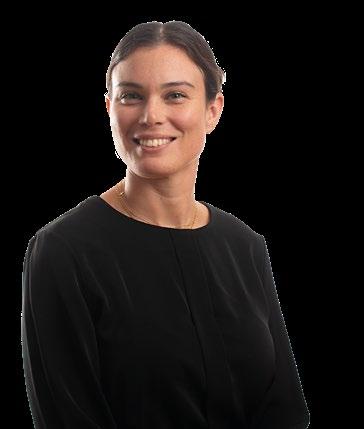 • Eleni Antipa (Crewing Assistant)
• Eleni Mathioudaki (Crewing Assistant)
• Eleni Antipa (Crewing Assistant)
• Eleni Mathioudaki (Crewing Assistant)
12 Issue 87-March 2024
• Xenia Sarantidi (Crewing Assistant)
Voices from the Fleet (2)


In some Eastern Orthodox Christian traditions, the practice of hiding a coin in a cake or bread is associated with Saint Basil (Vasileios in Greek), who is celebrated on January 1st. This day coincides with the celebration of the New Year in many cultures.
The story goes that during a time of famine, the people of Caesarea (where Saint Basil was the bishop) gathered food and resources to offer to those in need. Saint Basil wanted to distribute the goods fairly but faced the challenge of identifying each family's share. To solve this, he suggested baking coins into the bread, ensuring that each family would receive what was rightfully theirs.
This charitable act of Saint Basil became a tradition, and in commemoration of his kindness, a coin is often hidden in a cake or bread during the New Year's celebrations. The person who finds the coin is believed to receive a special blessing or is considered especially fortunate in the coming year. This tradition blends the spirit of generosity and charity associated with Saint Basil with the joyous festivities of the New Year.
Continuing the tradition, we asked those on board our vessels to bake pies and hide a coin to celebrate this custom.
Here are some of the winners:

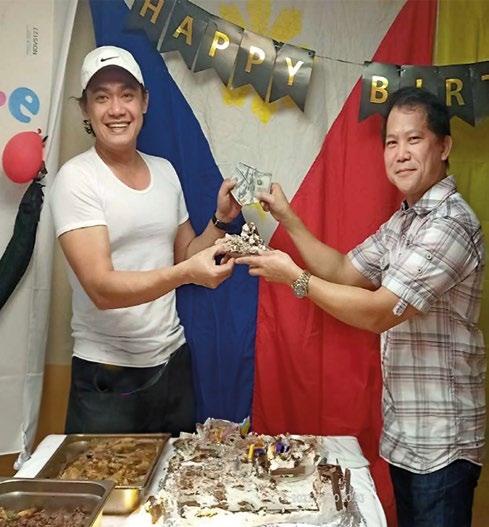



 Introduced and compiled by Chara Markatzinou
• OS CAPUL Joshua (M/V Danae)
• D.Trainee TAN Rheev Wilhemsen (M/T Ruby)
• C/S ALUNDAY Rodolfo, M/V Evgenia
• Stwrd CASTILLO Jake (M/V Venture)
• 3/E FEBRER Peter John (M/V Irina)
Introduced and compiled by Chara Markatzinou
• OS CAPUL Joshua (M/V Danae)
• D.Trainee TAN Rheev Wilhemsen (M/T Ruby)
• C/S ALUNDAY Rodolfo, M/V Evgenia
• Stwrd CASTILLO Jake (M/V Venture)
• 3/E FEBRER Peter John (M/V Irina)
13
• Tr. 2nd Engineer ISAIEV Denys (M/T Namrata : It was his decision to donate his lucky coin to the Assistant Cook and Catering Trainee for their hard work during the preparations for the Christmas celebration.)

MESSAGE FROM THE DPA:
How are Diversity, Equity & Inclusion relevant to Safety?
Dear seafarers,
The time to spread the word of DEI merits has come! Why are these concepts important to our life and our work? Why are they important to the seafarer? The shipping industry is so diverse! Different nationalities, different cultures, different work locations on shore and at sea, different genders, different age groups trying to communicate… the list is endless!
We need to be open minded to respect and accept all these differences. Because without respect, we fail to communicate and cooperate effectively, and thus, will fall short of our high standards of Safety.
Our new Care & Welfare manual sheds some light on these values of respecting and accepting. They are what we need to believe in and promote at every opportunity.
Each and every one of us can become an ambassador of these values to raise both the quality of our lives and the standards of our safety culture.
I wish you safe voyages and safe return home,
Elli Moretti

Diversity, Equity and Inclusion was one of the main topics discussed during our latest forum in India

Uniformity is not the key to RESPECT

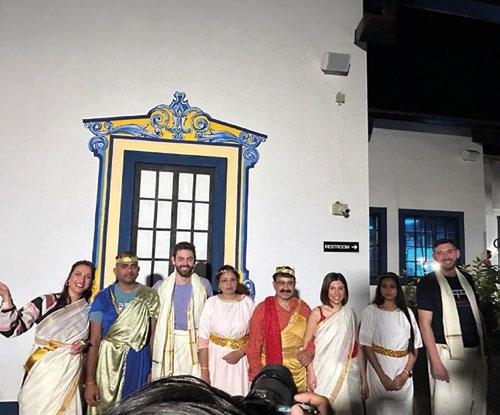
CARE brings together different cultures, nationalities, genders, age groups


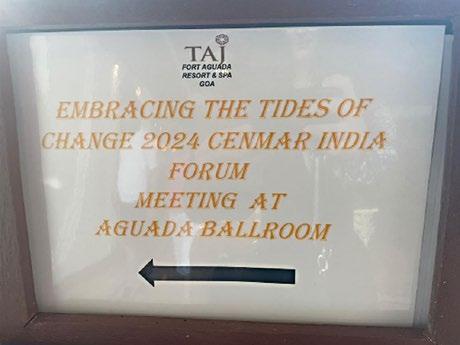
from the SQE Department SAFETY FIRSΤ!
Communication is! To Know Us Better 14 Issue 87-March 2024
Our goal is to ensure our Seafarers as well as those ashore feel fully supported so that they can stay positive and engaged, whatever challenges come along. Well-being is fundamental to our health and overall happiness, helping us to overcome difficulties both at work and at home. Now we have a new manual to support our efforts.
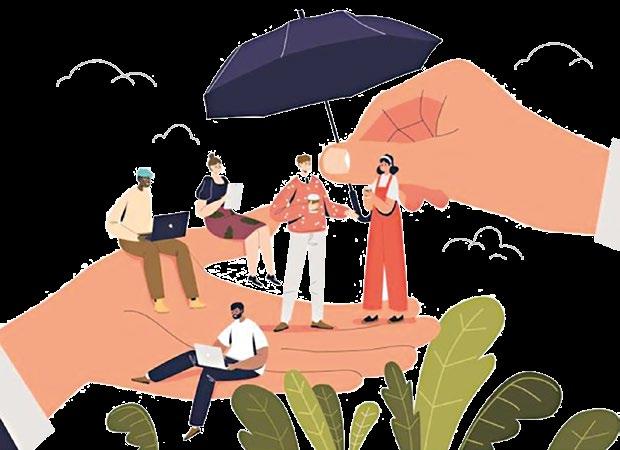
You can become a Care & Welfare Ambassador on board your ship


Care & Welfare Ambassadors on board the vessels will:
• Report any related issues to the Mental Health Officer.
• Give feedback with regard to their activities on board.
• Communicate health initiatives related to Company culture and ensure that health & safety campaigns are properly followed.
• Stay in touch with one another so that they collaborate, share ideas and overcome challenges.
• Organize recreational activities (i.e. National holiday nights, Birthdays, Seafarer’s Day, Father’s Day, New Year’s pitta cutting) that promote bonding and well-being on board.
• Inspire Seamen to share their experiences in the “Voices from the Fleet” section for the quarterly bulletin.


ZERO ACCIDENTS
15
Mental Well-Being
Navigating Diversity, Equity, and Inclusion: Empowering Seafarers for a Unified Maritime Future
In the vast expanse of the world's oceans, diversity, equity, and inclusion (DEI) play a crucial role in shaping the maritime industry. Seafarers, the lifeblood of global trade and transportation, come from diverse backgrounds, cultures, and regions. Fostering a culture of diversity, equity, and inclusion not only enriches the seafaring community but also strengthens the industry's resilience and adaptability. Let us explore the significance of DEI in the maritime world and contemplate on the measures that can be taken to ensure a more equitable and inclusive environment for seafarers.
The Essence of Diversity in Maritime
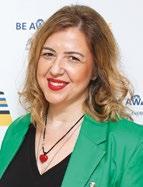 By Chara Markatzinou
By Chara Markatzinou
Diversity among seafarers includes – but is not limited to -- factors such as gender, ethnicity, age, and educational background. Recognizing and embracing this diversity is essential for the maritime industry's success. Different perspectives and experiences contribute to innovation, problem-solving, and overall resilience in the face of challenges.
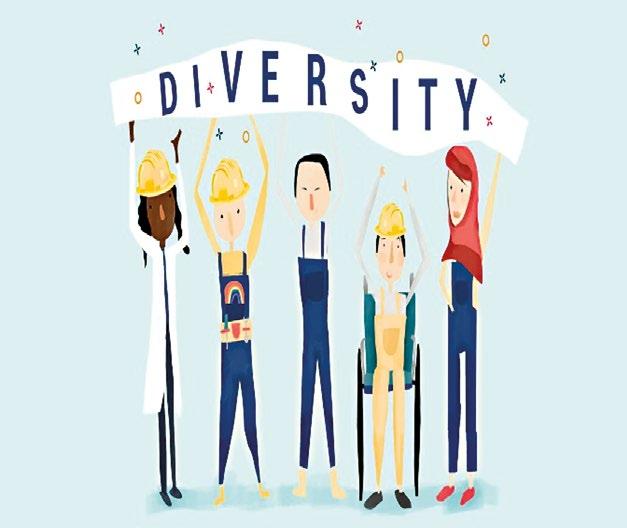
A diverse workforce in the maritime sector not only reflects the global nature of the industry but also enhances its adaptability to changing conditions. Seafarers from various regions bring unique skills, cultural insights, and language proficiencies, facilitating effective communication and collaboration on ships and during port operations.
Equity: A Fair Sea for All
Equity in the maritime context refers to ensuring fairness and impartiality in opportunities, treatment, and access to resources for all seafarers. Historically, the maritime industry has faced challenges related to gender and nationality-based disparities. Achieving equity requires addressing these disparities and

fostering an environment where every seafarer has equal opportunities for career advancement, training, and personal development.
Efforts to promote equity in the maritime industry include creating policies that combat discrimination and bias, offering equal access to training and education, and actively encouraging underrepresented groups to pursue careers at sea. Additionally, organizations can implement mentorship programmes to support the professional growth of seafarers, irrespective of their background or identity.

Inclusion: Building Bridges across the Waves
Inclusion goes beyond merely having a diverse workforce; it involves creating an environment where every seafarer feels valued, respected, and empowered to contribute their best. Inclusive practices promote collaboration, teamwork, and a sense of belonging, fostering a positive and harmonious work atmosphere on ships and in port facilities.

16 Issue 87-March 2024

“We will all profit from a more diverse, inclusive society, understanding, accommodating, even celebrating our differences while pulling together for the common good.’’
To cultivate inclusion among seafarers, maritime organizations can implement initiatives such as diversity training, cultural awareness programmes, and affinity groups. These efforts not only raise awareness about the importance of inclusion but also provide practical tools for seafarers and maritime professionals to foster a more inclusive workplace culture.
Challenges to DEI in Maritime
Despite the growing recognition of the importance of DEI in the maritime sector, several challenges persist. Gender disparities, for example, continue to be a significant issue, with women being underrepresented in various roles within the industry. Addressing stereotypes and biases, providing equal opportunities for training and career progression, and promoting a culture of respect are crucial steps toward achieving gender equity at sea.
Nationality-based discrimination is another challenge, as seafarers from certain regions may face prejudices or limited opportunities compared to their counterparts. Organizations and regulatory bodies must work together to implement policies that ensure fair treatment for all seafarers, regardless of their nationality.
Overcoming these challenges requires a collective effort from maritime stakeholders, including ship owners, operators, training institutions, and regulatory bodies.
The Way Forward: Strategies for DEI in Maritime
1. Education and Training:
• Implement comprehensive diversity and inclusion training programmes for seafarers and maritime professionals.
• Promote cultural awareness and sensitivity to foster a respectful and inclusive environment on board ships.
2. Mentorship Programmes:
• Establish mentorship programmes to support the professional development of underrepresented groups in the maritime industry.
• Encourage experienced seafarers to mentor and guide newcomers, creating a supportive network within the industry.
3. Equal Opportunity Policies:
• Enforce and communicate policies that ensure equal opportunities for career advancement, training, and education.
• Monitor and address any instances of discrimination, bias, or unequal treatment promptly.
4. Promoting Diversity in Leadership:
• Encourage and support diversity in leadership roles within maritime organizations and on ships.
• Showcase successful stories of diverse leaders to inspire aspiring seafarers from all backgrounds.
Diversity, equity, and inclusion are not just buzzwords; they are the cornerstones of a resilient and forward-thinking maritime industry. By embracing the richness of diversity, ensuring equity in opportunities, and fostering an inclusive environment, the maritime sector can navigate the challenges of the present and future with strength and unity. Seafarers, regardless of their background, deserve a workplace where their skills are recognized, their voices are heard, and their contributions are valued. Through concerted efforts from all stakeholders, the maritime industry can set sail towards a more diverse, equitable, and inclusive future.
Ruth Bader Ginsburg
17

Introducing our Shore Staff

Antigoni Klimi
My name is Antigoni Klimi and I have been working as an Assistant Accountant for the Company over the past two years.
I am primarily responsible for processing invoices related to technical, operational, crew and legal issues and undertaking the payment of suppliers and creditors in an accurate, efficient, and timely manner. The best and most interesting part of my job is finding the perfect balance between managing cash flow and maintaining positive vendor relationships, always ensuring compliance with financial regulations. I am really grateful for the collaborative spirit in both my team and across the departments which is fostering a positive work environment.

Mourtzouchos Georgios
As part of the Accounts Department’s team, I have been working as a Financial Controller of the Company for the last 6 years. My studies include a bachelor’s
In this new section, introductions to our shore staff will be made so that their duties, values and perspectives can be shared. So, let’s meet the members of our ACCOUNTS DEPARTMENT
degree in Accounting and Finance from Athens University of Economics and Business, a master’s degree in Shipping, Trade & Finance from Cass Business School, as well as full membership in the professional bodies of ACCA and CFA.
My responsibilities include the full function of internal and external reporting, the processing of invoices and supervision of data recording. In addition to the above, I act as a deputy to perform the daily treasury duties in the absence of the Finance Manager. Throughout these years, I feel bonded by the healthy and productive working environment, the kindness of my colleagues and the rewarding opportunities for professional growth.

Ioanna
My name is Ioanna Vassalou and I studied Economics at Panteion University. I have a master’s degree in Accounting and Finance and a certification in Taxation. I have six years’ experience in accounting and I have been working as an accountant at the Company for more one year. Some of my responsibilities are the data entry of invoices, the reconciliation of suppliers’ statements, payment preparations,
communication with the suppliers and the reconciliation of credit cards. I' m grateful to be a member of this Company, as we have an excellent cooperation with all departments. We constantly set new goals and do our best to achieve them. In conclusion, I’m glad to be part of this team, as I work with remarkable colleagues and I believe that my department contributes to the smooth operation of the whole Company. Be safe!

Katerina Sapoznikova
Hello everyone!
I am excited to share my journey at the Company with you all. I started here back in 2020 as a receptionist but opportunity knocked unexpectedly and now I am proud to say I am working as an assistant accountant. I have many and different responsibilities and it is a really big change from my tourism background, but I have learned so much along the way. You can never predict what life has in store, so never say never! I am very lucky to have amazing colleagues who are always ready to help out, to support and share their knowledge. I am also really grateful for this journey that has led me to where I am today and the opportunity to contribute to this vibrant
community of seafarers. To our brave seafarers, the most important thing that I have realized working for our Company is that your sacrifices do not go unnoticed and your hard work is really appreciated. Your courage knows no bounds and your commitment to your craft inspires us all. I read something nice recently and I would like to share it with you: Smooth waters may bring comfort, but it’s the rough seas that reveal one’s true character.
Stay strong! Stay safe!

Alefragis
Lefteris
I am Alefragis Lefteris and I have been working at the Company since 2000. I started at lower positions, waiting for the opportunity to advance.
After years of specialization alongside experienced accountants, the Company recognized my abilities and entrusted me with the position of management and control of the Master's accounts (MGA).
Νow I consider the Captains on our ships as close collaborators/ colleagues, just like the colleagues in the office.

Lykourgos Soulimiotis
My name is Lykourgos Soulimiotis and I have been working for the Company for 27 years as a disbursements accounts control officer. My primary role involves ensuring timely settlement of port expenses to facilitate smooth operations for our fleet vessels.
I am proud to be part of the Company family and greatly appreciate the collaboration of the office team in achieving operational excellence for the vessels.

Mammas Sarrigiannis
Born and raised on Kalymnos Island, a picturesque area known for its rich maritime history, I hold a degree in Business Planning and Information Systems and a master’s degree in Banking. My education provided me with a strong foundation in financial analysis and management, as well as information technology, facilitating my career in the shipping industry. Since 2011 I have been working in the shipping industry, as an accountant and MGA Controller. For
Vassalou
18 Issue 87-March 2024

the past one and a half years I have had the honour of being a member of this family. My experience here has enriched my knowledge and expanded my skills in analyzing and solving complex issues, elements that are critically important resources in the successful management and development of the Company.

Maria Markou
Hello, I am Maria Markou, a 28-year-old professional with a degree in economics. After three years as an accountant in an accounting office, I transitioned to my current role as an assistant accountant in the Company a year ago.For me, being a part of the Accounts Department involves collecting all Greek invoices, creating the accounting entries, and then proceeding with payments.
In this journey, which started a year ago, there are only good things to share, and overall, it is nice to be a part of this team.

Michalis Verropoulos
I am Michalis Verropoulos and I joined the Company in 1996. As a Finance Manager, I am responsible for
the supervision of the Accounts Department, the Company’s liquidity and working capital management, as well as the daily treasury function. This includes the reporting of the Company’s receipts, payments, deposits and debt liabilities. In addition to the above, my duties also include collaborating with other departments to achieve the desired monetary goals.
My long lasting loyalty to the Company is mainly attributed to the mutual respect and the strong bonds I have developed during all these years with my colleagues and management alike.

Nikolaos Zenempisis
My name is Nikolaos Zenempisis and I am 47 years old.I am an assistant accountant and my responsibilities are keeping the book ledger of income and expenditure and other various entries, hard copy filing, petty cash, and external work for the Company such as banking and consulates.
I had three years of study at BCA Shipping College and for the last 23 years I have been working at the Company.
I am grateful that I am a part of this Company and a member of this extended family. This is a Company where the employee’s welfare is given top priority, and I believe we all appreciate the values of respect and humanity that define our workplace.

Paraskevi Petridi
"One's destination is never a place, but a new way of seeing things." H.Miller
For many years I have been reporting, consolidating accounts and dealing with our creditors. In my case, I cannot pinpoint when I started to see things differently. It was probably after I took up my new duties in the MGA Dept. and through the correspondence I had with our Captains regarding the MGA module implementation that I was assigned to. Some kind of "aura" must have blown in from the sea, opened up the limited space of our office and revealed the daily experiences of our Seafarers on the oceans. The balance sheets were transformed from mere numbers into human entities! What was even stranger was that the same winds brought me a new personal quest on behalf of societies across the globe and the culture of our Seamen. From the Mediterranean and the Red Sea to the Indian Ocean reaching the 7,500 islands of the Philippines, our Seafarers do an incredible job in keeping the world going day after day.
This connection is of paramount importance.
As I have discovered, empathizing with our 1020 Seafarers who travel every day brings us very close to those who give so much to this Company. Thank you.
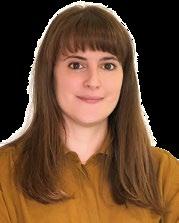
Calliope Mastrokalou
My name is Calliope Mastrokalou. I am an Accounting Assistant and I have been working in the Company for the last 5 years. My background consists of studies in Business Administration, followed by a master’s degree in Maritime Studies at the University of Piraeus. As an Assistant Accountant, I am responsible for the processing of insurance documents (Hull & Machinery, Loss of Hire, War Risk, FDD, P&I, Crew Insurance and Claims), the preparation of payments as well as the filing of the tax documents required by the Greek tax authorities.
The shipping industry sector has always fascinated me and I am very grateful to our Company for giving me this opportunity. I am also very pleased to work in such a rewarding and team-oriented working environment.

Aristotelis
My name is Aristotelis Madenzis. I have been with the Company for the past 28 years, a lifetime, a journey. I work for an outstanding and dynamic Company, an example to be emulated by others. It is a great school.
The Company has created a constructive environment and I have supportive colleagues. I enjoy my work, I enjoy life. In the past year, I was promoted to Accounting Manager. My department is staffed by friendly and kind employees, who are distinguished by their dedication, professionalism, and willingness. As a team, our goal is to increase efficiency and modernize processes. I am proud that as a department, we contribute to the success of the Company.

Katerina Politou
Being an accountant is something that I have always found fascinating and intriguing. It has equipped me to think more analytically and critically.
Since 1996 I have been offering my services to the Company. Some of my responsibilites include updating and maintaining the “Incomes – Expenses” books, dealing and managing payment to Greek service providers and vendors, reconciliation of accounts and submitting tax statements to public authorities.
Working for a Company that encourages intiatives and has a positive culture is both rewarding and challenging. It is like a journey of development, self-improvement and acquistion of new skills. A constant learning experience!
Madenzis
19
It goes without saying that the way we work has changed over the past few years with the rise of remote and hybrid working along with a build-up of health and safety protocols in order to manage and mitigate the effects of Covid-19 and other shocks. Furthermore, great advances in technology have fuelled huge changes in how we work.
How have Maritime Operations changed over the past 20 years?

Let’s discover how different Ship Operations are today with the assistance of Operations Manager, Mr. Fivos Christopoulos
Q1. How long have you been with the Company and what were your first impressions when you joined?
I joined the Company as a part time trainee for the position of assistant in the Freight Collection Dept. back in June 2001. At that time, I was doing my military service in the Greek army and I would only come to work in the afternoon for four hours to do mostly administrative work. As soon as I completed my military service in March 2002, I was employed on a full-time basis and remained in the Freight Collection Dept. until 2004, when a vacancy arose for the position of an Operator which I applied for. The Company trusted me by giving me the opportunity to join the Operations team under the supervision of our late Captain A. Stellatos.
Q2. How do you feel now that you have been with the Company for 23 years?
I honestly still cannot believe that almost 23 years have passed since the day I first entered this building... I feel blessed for having had the opportunity to join the Company and develop my skills here. I am grateful for having been given the responsibility to take on tasks and assignments, which I have always completed to the best of my ability to achieve the best possible outcome.
procedures, but also the Company itself which has grown not only in size but also by investing in and striving for excellence in Safety, Security and Environmental standards.
Q4. Going forward, do you think it is important to recruit younger people or can the previous generations meet all requirements?
 By Vaia Kyrodimou
By Vaia Kyrodimou
Undoubtedly we can only be successful by engaging the younger people to assist us in accomplishing the Company's missions. They only need to share the same vision as us, build on it when the opportunity arises and have the willingness to learn and develop. We are here to share our knowledge and experiences with them, but also to learn from the young colleagues, and it is up to each one of us all to grasp the opportunity, work hard and grow professionally together.
Q5. Name two things that haven't changed in our Company since you joined.
The only things I would say that have not changed in this time are the Company's culture and the feeling that we are all a family.
Q6. Why do you think these have not changed?
I would say that when something works, and clearly the Company’s culture does, it should be reinforced and continue to be adopted. Although it is said that nothing remains the same because people change, roles and positions change, requirements change, and our job changes almost on a daily basis, the need for a sense of belonging is inherently human, so perceiving the Company as family helps fulfill this basic need.
Q7. Communication is one of the areas where there is a lot of focus today - shore/ship, ship/ship, office/charterers, intra office, etc. How do you think communication has changed, not only from a technical viewpoint, but also as far as the parties/ individuals are concerned?
Communication has always been vital. It was one of the first things I learned when I joined the Company. Over the past few years the industry has been heavily regulated, the stakeholders (Charterers, Agents and Contractors etc.) have also developed and increased their requirements and our role in the Operations is to make sure that all relevant parties receive the information they need so that the voyage is concluded successfully. It is more important than ever that we focus on effective communication, build relationships with our colleagues and associates and maintain open channels in order to promote safe and successful operations and, of course, engage in troubleshooting when required.
Q8. I know that this is a difficult question to answer, but what do you believe the future holds for this Company and the industry as a whole?
Q3. How different are Ship Operations today from what they used to be when you joined the Company?
Ship Operations have changed considerably since I joined the Company. It is not only the industry in its entirety which has changed by engaging new regulations, requirements and
That is definitely a tough one and unfortunately no-one has a crystal ball to know what the future holds for us. Nevertheless, I can only tell you with confidence that as long as we strive for excellence, work hard, maintain our commitment to Safety, Security and Environmental sustainability, the future will only hold good surprises for us all.
.
Moving Forward, Looking Back Regulations Development Professional Growth Willingness Family Communication Company Culture Younger Generation Commitment Opportunity Excellence Gratitude 20 Issue 87-March 2024
The Bahamas
The Registry
It has been over 30 years since the first ship was registered with the Bahamas Ministry of Transport. In 1995, management of the Register was transferred to the Bahamas Maritime Authority (BMA) due to rapid growth that led to an increasing international presence.
Today, the BMA registers vessels in Nassau, London, New York, Hong Kong and Greece, which confirms its international standing. In addition, the BMA represents the country at the IMO, the European Commission and the US Coast Guard, with whom it has maintained Qualship 21 status since 2011. As regards White Lists, the BMA has occupied those of the Paris and Tokyo MOUs for over 17 years, which confirms its current primary function of enforcing ship safety requirements and continuously improving standards.
In 2023, the BMA was the 8th largest registry in terms of tonnage, which was more than 72 million dwt. There are over 1500 ships registered with the BMA, which represent a wide range of market sectors, including passenger ships, dry bulk, tankers, container vessels, LNG/LPG ships, yachts and Ro Ro vessels. As regards the top country-owned vessels registered with the BMA by gross tonnage, the top five are Greece (17%), Norway (15%), USA (11%), Canada (10%) and Japan (9%).
Each and every one of the vessels registered with the BMA has access to the registry’s worldwide network of over 200 approved inspectors, auditors, surveyors, technical and operational staff throughout the year. With such support and a clear vision for excellence, the BMA is certain to continue operating at the highest level.
The Country
Consisting of nearly 700 islands, about 30 of which are inhabited, the Bahamas is an archipelago that stretches over 500 miles (800 km) from South East to North West. At one end there is Grand Bahama Island, which lies 60 miles (96 km) off the Florida coast and at the other is Great Inagua, which is approximately 50 miles (80 km) from Cuba. The most heavily populated island is New Providence, on which the capital, Nassau, stands. Of the total population of around 412,000, over 72% live on this island. Other islands with significant populations are Grand Bahama (47,000), Abaco (16,500) and Eleuthea (over 9000).
The Bahamas is dominated by extensive areas of flatlands, just metres above sea level. There are some hills, but they only reach around 100ft (30 m) and the highest point is only 206ft (63 m). There are no rivers on the islands, but there are large lakes on Great Inagua and plenty of fresh water on Andros Island.
The Bahamas enjoys a mild climate throughout the year with average temperatures in the low 70s F (21oC) and the low 80s (27oC) during winter and summer respectively. Although the soils are generally shallow, there are Caribbean pine forests on the most populated islands and Andros Island. Similarly, the presence of the little arable land has not prevented the agricultural sector from producing tomatoes, mangos, pineapples, bananas and grapefruit. Moreover, pigs, cattle and sheep are reared in the Bahamas. As regards the fishing industry catches are mainly dependent on the numbers of spiny lobster, grouper and conch that are landed.
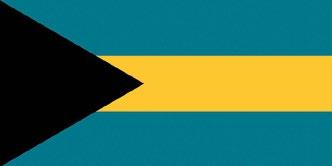
en.wikipedia.org
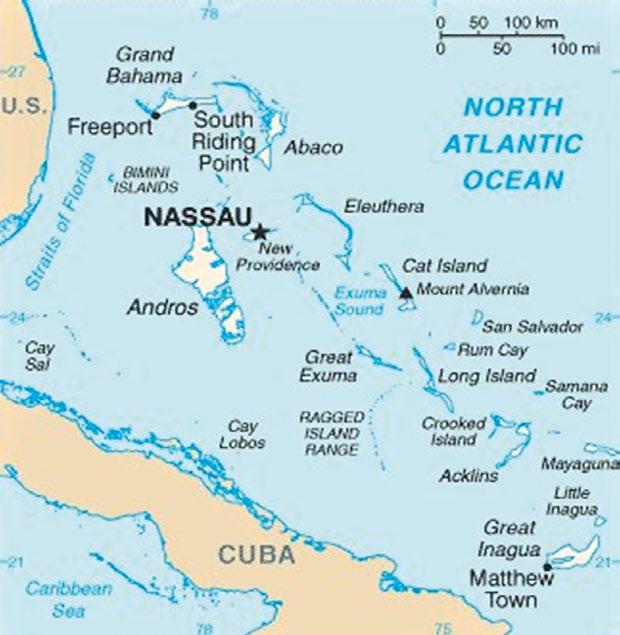
Map of the Bahamas Source: www.scuba-diving-smiles.com
An idea of how beautiful the wildlife in the Bahamas is can be gained from the country’s national bird, fish and flower. These are the iconic flamingo, the magnificent blue marlin and the wonderful native yellow elder respectively. Other creatures include the agouti, raccoon, iguana as well as several frog, lizard and snake species, none of which is venomous. Many of these inhabit national parks run by the Bahamas National Trust, which strives for the preservation of wildlife on the archipelago. In all, there are some two dozen parks, including the Exuma Cays Land and Sea Park, which was established in 1959.

National bird of the Bahamas
Source: www.southernboating.com

National flower of the Bahamas
Source: en.wikipedia.org

National fish of the Bahamas
Source: en.wikipedia.org
Of course, no description of the Bahamas would be complete without at least a mention of the magnificent beaches and crystal clear waters that abound across the nation. These attract tourists who enjoy snorkeling, windsurfing, deep-sea fishing, sailing and diving to observe sharks, rays, moray eels as well as shipwrecks. Successful tourism and financial service sectors have propelled the GNP of the Bahamas to one of the highest in the region. It is an accomplishment that the country can rightly be proud of.
Sources: www.bahamasmaritime.com, www.unctad.org, www.lexology.com, www.britannica.com, www.citypopulation.de
Registries and Countries
21
Flag of the Bahamas. Source:
Captain James Cook
James Cook was born in Marton, a town near Middlesborough on 27th of October 1728. His early education was limited and when it ended, he took up an apprenticeship with a local grocer called William Sanderson. The shop he worked in was near to Staithes Harbour, and he soon realized that his dream was to go to sea. It was a dream he made known to his employer, who kindly introduced the young apprentice to John Walker, a friend of his who was a ship owner from Whitby.
His new employer gave him the position of apprentice seaman, and he attended school with other apprentices. As a result of his hard work, he was given a chance to prove himself aboard a coal carrier that ferried cargo to London.
He performed his duties very well and at the age of 21, was rated an able seaman. His progress continued, which led to him being promoted to mate three years later. In 1755, James Cook was offered command of one of the Walker’s vessels, but he politely declined in favour of seeking a position in the Royal Navy. Again he progressed quickly on board HMS Eagle, where he advanced to master’s mate and boatswain within two years.
His next move involved a transfer to HMS Pembroke, aboard which he assumed command at the age of 29. Prior to departing for Halifax, Nova Scotia on this ship in 1758, Captain Cook married Elizabeth Batt. They had six children, but sadly his wife outlived all of them. Away from his new wife, James Cook participated in the capture of Louisberg in late 1758 before embarking on an expedition to survey and map the St. Lawrence River to facilitate the safe navigation of those waters for British ships. It was aboard HMS Pembroke that James Cook achieved recognition. The Admiralty was made aware of the Captain’s abilities by Admiral Lord Colville, so he was given the task of surveying the coast of Newfoundland in 1763.
Captain Cook justified the Admiral’s recommendation and was asked to observe the 1769 transit of Venus from the South Pacific. This expedition was organized to provide the Royal Society with knowledge of the distance between the Earth and Sun. Additionally, Cook was tasked with searching for the Great Southern Continent. His ship on this expedition was a refitted vessel newly named the Endeavour. The expedition began when the Endeavour set out for Tahiti via Madeira, Rio de Janeiro and Tierra del Fuego in 1768. The first objective was realized without a problem, so before sailing to the east coast of Australia Cook charted New Zealand. The explorer landed in Botany Bay, claiming the land for Britain. After that he spent four months charting the coast. Everything was going smoothly until the Endeavour struck the Great Barrier Reef, a collision that left his ship with a gaping hole. After sustaining the damage she managed to reach a river where she remained beached for a while. The settlement near the river was named Cooktown to mark the event.

Cook depicted in a Nathaniel Dance-Holland portrait c. 1775.
Source: en.wikipedia.org

Captain Cook’s Monument, Kurnell. Source: en.wikipedia.org
1771. He remained on land for a year before his next expedition to find the Great Southern Continent began. He was provided with two vessels that were refitted and renamed Resolution and Adventure.
During this voyage, Cook ventured further south than any other explorer to that date, making him the first person to cross both the Arctic and Antarctic Circles. They scoured the region in search of the elusive landmass, but without success, so he returned to England in 1775.

Endeavour replica anchored in Cooktown, Queensland. Source: en.wikipedia.org
The following year, he sailed in search of a passage linking the Pacific and Atlantic Oceans. He did not find the route, so he made his way home via Hawaii in 1779. He had stopped over in Hawaii on his search for the passage, so he believed he would be made as welcome as he had previously been. He was correct as his relations with the locals remained amicable until he left.
Unfortunately, shortly after his departure he encountered a storm that forced him to turn back with a broken foremast. On this occasion, his stay on the island was far less cordial. A boat went missing, accusations were made, relationships became tense and an altercation followed. During the skirmish, Cook sustained wounds from which he did not recover. The locals honoured him with a ceremonial funeral in respect of his standing.
Captain James Cook altered the map of the world more than any other person in history. Apart from his mapping skills, he was elected a fellow of the Royal Society for his scientific prowess. Indeed, he was awarded the Copley Medal, one of the Society’s highest honours for his paper on measures to be taken against scurvy. Thus, his legacy lives on and now many towns bear his name, there is a monument dedicated to him in Sydney, a replica of Endeavour is anchored where the original was beached, and NASA have named a shuttle after this ship.
After repairs were completed, Cook returned to England in July
Sources: www.historic-uk.com, www.britannica.com, www.en.wikipedia.org
Pioneers of the Waves
22 Issue 87-March 2024

Test Brain your

1. Make the names of TWO Company vessels using all the letters in the following sentence:
I NEED SUGAR, MARU
2. The letters in the chemical symbols for hydrogen, oxygen, nitrogen and ruthenium can be rearranged to form the name of a lake in the U.S which is a little larger than Croatia. What is the name of the lake?
3. My name goes with the word ‘distress’ and when I go off, I can cause stress. But my job is to give warning that something is not right, so you never ignore me whether it be morning or night. What am I?
4. Which three-letter word can be used to complete the following words?
R_ _ _ ING, CR_ _ _ Y, THERE _ _ _ ER and CR _ _ _ SMAN?
5. Joe enjoys visiting America, especially the states of Alabama, Iowa and Idaho. He also likes Dubai and Cairo. His favourite animal is the aye aye and his favourite bird species is the eagle. By the same token, which fruit does he prefer: an orange or an avocado? Why?
6. Which four-letter word can be placed after the words to the left and before the words to the right?
BOXING
7. In 4 steps change the word ROCK to SAND by changing one letter at a time to form intermediate words.
8. What is the missing number (X)?
1. Which US submarine first circumnavigated the globe without surfacing in 1960?
A. Triton B. Skate C. Nautilus D. Sculpin
2. How many of the following cargoes are hygroscopic? Coffee, cotton, salt and sugar?
A. 1 B. 2 C. 3 D. 4
3. Which of the following is a cargo that is NOT classified as posing a risk from liquefaction?
A. ilmenite sand B. coal slurry C. nickel ore D. pig iron
4. What was the name of the vessel that transported Welsh emigrants to Argentina?
A. Mayflower B. Mimosa C. Empire Windrush D. Flying Cloud
5. In what year did the Company acquire its first vessel, Ninemia?
A. 1991 B. 1993 C. 1995 D. 1996
Answers
6. Which of the Great Lakes is closest to the cities of Buffalo and Cleveland?
A. Huron B. Eerie C. Superior D. Michigan
7. What was the name of the vessel that caught fire after her cotton cargo spontaneously combusted?
A. Roxburgh Castle B. Earl of Eldon C. Cutty Sark D. Tilikum
8. When was the Panama Shipping Registry established?
A. 1910 B. 1925 C. 1940 D. 1950
9. IThe 80th session of the IMO’s MEPC was held in London in July 2023. What does the ‘C’ in MEPC stand for?
A. Congress B. Congregation
C. Consultancy D. Committee
10. Which famous explorer was killed on the island of Mactan in the Philippines?
A. Captain James Cook B. Zheng He C. Ferdinand Magellan D. Sir Walter Raleigh
Fun Corner
- - - - -
HOLLOW
DIAMOND
FINGER
CAMERA
FILE
0 1 1 2 2 3 3 4 36 100 224 X 2 3 3 4 4 5 5 6 TEST YOUR BRAIN answers: 1. SEMERU, GUARDIAN 2.Huron 3. Alarm 4. AFT 5. An avocado. All his choices contain more vowels than consonants. 6. RING 7. RACK, RANK, SANK, SAND or SOCK, SACK, SANK, SAND etc. 8. 432 (add the cubes) • QUIZ answers: 1. A 2. D 3. D 4. B 5. B 6. B 7. B 8. B 9. D 10. C Answers at the foot of the page Answers at the foot of the page Quiz Houston, we have a problem! 23
Timothy Shaddock Survival at Sea
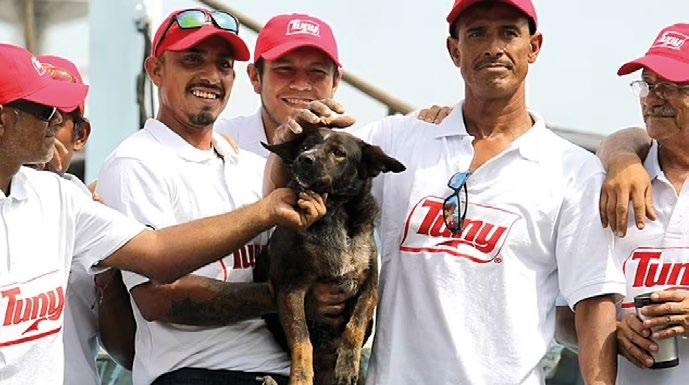
Source: www.dailymail.co.uk
Not many people in their fifties would consider leaving a corporate job in IT in favour of pursuing a dream. Yet that is exactly what Australian, Timothy Shaddock, did. His dream was to sail solo from Mexico to French Polynesia, a distance of 3,728 miles (6000 km).
In May 2023, Mr. Shaddock departed from La Pez on the Baja Peninsula in Mexico. He was not entirely alone, though, because he was accompanied by a stray dog he had adopted and named Bella during his time in Mexico. Shortly after their departure, his catamaran called Aloha Toa was hit by a storm, which caused so much damage that his boat quite literally became as functional as a raft, thereby leaving him at the mercy of the prevailing current.

Source: www.foxnews.com
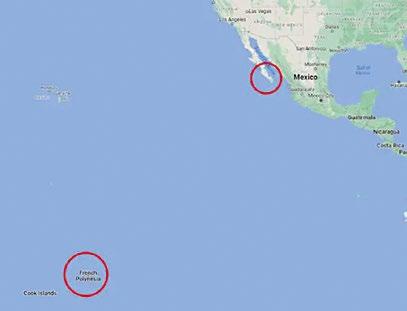
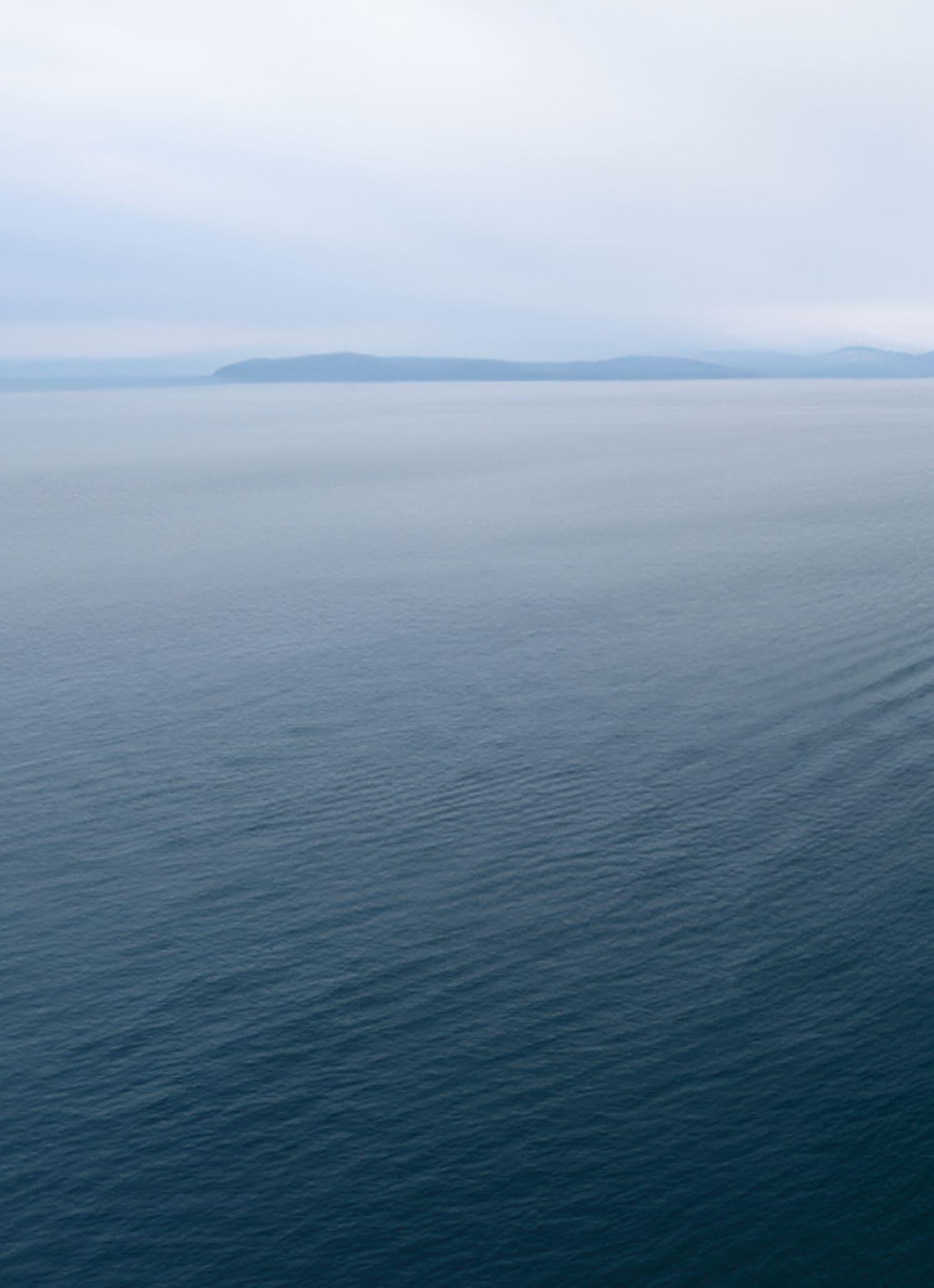
The storm put paid to his plan to engage in a long fishing expedition and to reach French Polynesia aboard his catamaran. Instead of having an enjoyable voyage, Mr. Shaddock was plunged into survival mode. Fortunately, he had prepared quite well for the journey in terms of provisions, which were left largely intact after the storm. However, he still needed to supplement the food and drink he had left with by fishing and collecting rainwater.
After spending almost three months adrift he, or rather his small boat, was spotted by a helicopter pilot who was on the lookout for tuna about 1200 miles (1920 km) from land. The pilot informed a Mexican tuna trawler of the drifting catamaran, and the fishing vessel called Maria Della soon made contact with Mr. Shaddock and Bella. The crew found him somewhat shell-shocked. He had an unkempt beard and looked decidedly the worse for wear. Naturally, he was extremely grateful to the fishermen for rescuing him.
Once aboard the trawler, Shaddock was given medical attention and treated for dehydration by the crew led by Captain Oregon. He recounted his experience, emphasizing he fear of never being found in the vast ocean. He also revealed that his time adrift was a series of high and lows and that he owed a lot to Bella for providing him with vital companionship on the catamaran.
Back on land in Manzanillo, Mexico, it was obvious that Timothy Shaddock had lost a considerable amount of weight. However, an attending doctor reported that his condition was stable and that his vital signs were normal, but he would have to return to eating normally over a period of several months. The completion of the rescue also saw Shaddock part with his canine companion, Bella. The crew really took to her, especially a fishermen called Genaro Rosales, who vowed to take good care of her as Shaddock could not readily return to Australia with her. The adoption was just one of many reasons why Shaddock was indebted to Gruponar, the owner of Maria Della, as the company went above and beyond in their rescue and in the care they provided for the Australian adventurer.
After regaining his composure following his rescue, Shaddock was able to talk about a future that he truly never believed would materialize while he was drifting helplessly in the ocean. He talked of reuniting with family down under. He also commented on his future relationship with the sea, stating that he was open to the idea of getting on a boat again, but was unsure of how far from land he was willing to venture.
Source: www.anews.com, www.cnn.com, www.nytimes.com, www.theguardian.com, ww.globalnews.com, www.9news.com.au
Some of the crew aboard Maria Della with Bella after the rescue
Timothy Shaddock undergoing medical following his rescue
Timothy Shaddock’s proposed voyage from Mexico to French Polynesia.
Source: www.businessinsider.com








 Eleni Prokopiou with padel runners-up Evaggelos Kollintzas and Mina Kotsaki and our fastidious MC Anthony Lambros taking a short, wellearned breather
Eleni Mathioudaki and Mando Rodopoulou displaying their lucky coins
Tucking into a mouthwatering dish
Eleni Prokopiou with padel runners-up Evaggelos Kollintzas and Mina Kotsaki and our fastidious MC Anthony Lambros taking a short, wellearned breather
Eleni Mathioudaki and Mando Rodopoulou displaying their lucky coins
Tucking into a mouthwatering dish



 Our basketball team
The finalists after their epic battle
The action on court provoked a range of reactions
Our basketball team
The finalists after their epic battle
The action on court provoked a range of reactions





 By Natassa Sakellariou
By Natassa Sakellariou





 Figure 3: EU ETS based on percentage of emissions on voyages (DNV)
Figure 4: EU ETS introduction timeline (DNV)
Figure 3: EU ETS based on percentage of emissions on voyages (DNV)
Figure 4: EU ETS introduction timeline (DNV)



 Voices from the Fleet (1)
Figure 5: EU ETS Directive Application (ABS)
Voices from the Fleet (1)
Figure 5: EU ETS Directive Application (ABS)
 By Captain Delson Roche
By Captain Delson Roche




 By Eleni Antipa
By Eleni Antipa


 • Eleni Antipa (Crewing Assistant)
• Eleni Mathioudaki (Crewing Assistant)
• Eleni Antipa (Crewing Assistant)
• Eleni Mathioudaki (Crewing Assistant)







 Introduced and compiled by Chara Markatzinou
• OS CAPUL Joshua (M/V Danae)
• D.Trainee TAN Rheev Wilhemsen (M/T Ruby)
• C/S ALUNDAY Rodolfo, M/V Evgenia
• Stwrd CASTILLO Jake (M/V Venture)
• 3/E FEBRER Peter John (M/V Irina)
Introduced and compiled by Chara Markatzinou
• OS CAPUL Joshua (M/V Danae)
• D.Trainee TAN Rheev Wilhemsen (M/T Ruby)
• C/S ALUNDAY Rodolfo, M/V Evgenia
• Stwrd CASTILLO Jake (M/V Venture)
• 3/E FEBRER Peter John (M/V Irina)













 By Chara Markatzinou
By Chara Markatzinou






















 By Vaia Kyrodimou
By Vaia Kyrodimou













